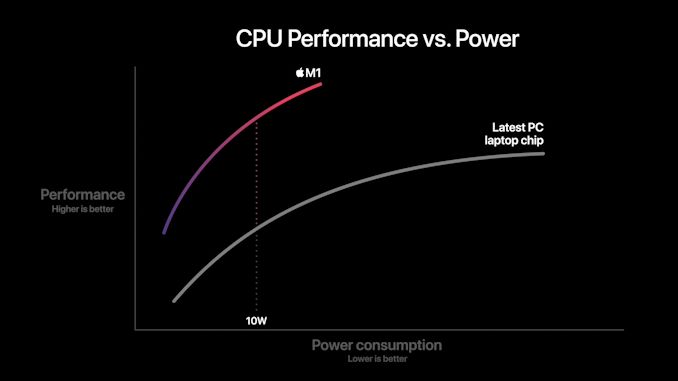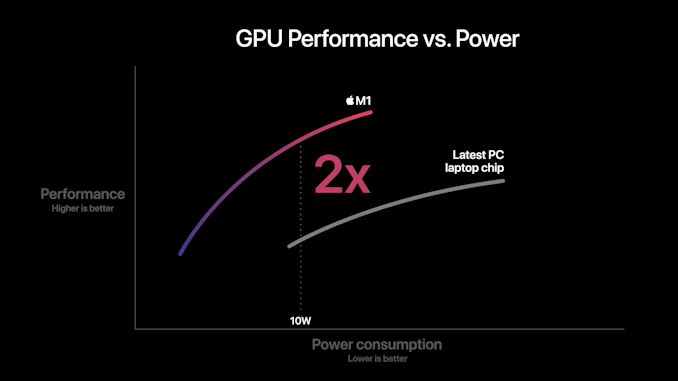Apple Announces The Apple Silicon M1: Ditching x86 - What to Expect, Based on A14
by Andrei Frumusanu on November 10, 2020 3:00 PM EST- Posted in
- Apple
- Apple A14
- Apple Silicon
- Apple M1
Apple Shooting for the Stars: x86 Incumbents Beware
The previous pages were written ahead of Apple officially announcing the new M1 chip. We already saw the A14 performing outstandingly and outperforming the best that Intel has to offer. The new M1 should perform notably above that.
We come back to a few of Apple’s slides during the presentations as to what to expect in terms of performance and efficiency. Particularly the performance/power curves are the most detail that Apple is sharing at this moment in time:
In this graphic, Apple showcases the new M1 chip featuring a CPU power consumption peak of around 18W. The competing PC laptop chip here is peaking at the 35-40W range so certainly these are not single-threaded performance figures, but rather whole-chip multi-threaded performance. We don’t know if this is comparing M1 to an AMD Renoir chip or an Intel ICL or TGL chip, but in both cases the same general verdict applies:
Apple’s usage of a significantly more advanced microarchitecture that offers significant IPC, enabling high performance at low core clocks, allows for significant power efficiency gains versus the incumbent x86 players. The graphic shows that at peak-to-peak, M1 offers around a 40% performance uplift compared to the existing competitive offering, all whilst doing it at 40% of the power consumption.
Apple’s comparison of random performance points is to be criticised, however the 10W measurement point where Apple claims 2.5x the performance does make some sense, as this is the nominal TDP of the chips used in the Intel-based MacBook Air. Again, it’s thanks to the power efficiency characteristics that Apple has been able to achieve in the mobile space that the M1 is promised to showcase such large gains – it certainly matches our A14 data.
Don't forget about the GPU
Today we mostly covered the CPU side of things as that’s where the unprecedented industry shift is happening. However, we shouldn’t forget about the GPU, as the new M1 represents Apple’s first-time introduction of their custom designs into the Mac space.
Apple’s performance and power efficiency claims here are really lacking context as we have no idea what their comparison point is. I won’t try to theorise here as there’s just too many variables at play, and we don’t know enough details.
What we do know is that in the mobile space, Apple is absolutely leading the pack in terms of performance and power efficiency. The last time we tested the A12Z the design was more than able to compete and beat integrated graphics designs. But since then we’ve seen more significant jumps from both AMD and Intel.
Performance Leadership?
Apple claims the M1 to be the fastest CPU in the world. Given our data on the A14, beating all of Intel’s designs, and just falling short of AMD’s newest Zen3 chips – a higher clocked Firestorm above 3GHz, the 50% larger L2 cache, and an unleashed TDP, we can certainly believe Apple and the M1 to be able to achieve that claim.
This moment has been brewing for years now, and the new Apple Silicon is both shocking, but also very much expected. In the coming weeks we’ll be trying to get our hands on the new hardware and verify Apple’s claims.
Intel has stagnated itself out of the market, and has lost a major customer today. AMD has shown lots of progress lately, however it’ll be incredibly hard to catch up to Apple’s power efficiency. If Apple’s performance trajectory continues at this pace, the x86 performance crown might never be regained.












644 Comments
View All Comments
grayson_carr - Wednesday, November 11, 2020 - link
Don't worry. Macs with the M1 are shipping to consumers right now. We'll have more proof one way or the other very soon.novastar78 - Wednesday, November 11, 2020 - link
Yea well let's see it first. These are all very generic and not relevant. Let's see the real world benchmarks of this thing blowing away a Ryzen 5950 desktop in gaming peformance and then you have my attention.Otherwise ....yawn
Spunjji - Thursday, November 12, 2020 - link
@novastar78 - Why would you expect to see a mobile chip that's going to be used for MacOS "blowing away" a 5950X in games? Who's going to be running games on this thing as a primary purpose? The platform doesn't have many of them and it can't do Bootcamp.The fact remains that gaming performance is one aspect of a CPU, and in the other ones that are more relevant, this architecture kicks ass.
star-affinity - Friday, November 13, 2020 - link
@SpunjjiiOS/iPadOS games will be able to run directly on the Apple Silicon Macs, så there will instantly be a lot more games macOS. Should be relatively easy for developers to adjust those ”mobile” games to the more powerful hardware in a Mac. But sure, so far we don't have any Apple GPU in a Mac that can compete with AMDs and NVIDIAs latest offerings.
star-affinity - Friday, November 13, 2020 - link
så = sovais - Thursday, November 12, 2020 - link
Sorry to say it but you are deluding yourself. On one hand the article compares apple's to oranges without saying what exactly it's measuring - is it width, density, total mass, circumference? Or are we just comparing which colour is "better"?Continuing the fruit analogy it seems the article is measuring performance/watt, so density instead of total mass - get the difference?
It's a shame as the architecture details are actually amazing, but when it gets to the benchmark part comparing A14 to x86 it goes off the cliff hard. A measurement without any units or clear information on what is being measured is just drawing colourful lines...
Spunjji - Thursday, November 12, 2020 - link
@vais - are you even reading the same article? If you want an in-depth evaluation of what the SPEC tests do, go and read one of the dedicated articles that explain it. Otherwise it's "bigger bar better" unless the chart says otherwise, and it provides the units right alongside them. Bigger score in a SPEC test = better CPU for that task. Better scores overall = faster CPU overall.vais - Friday, November 13, 2020 - link
@Spunjji - let's wait a few weeks for actual workload tests like rendering and see how the miraculous M1 measures up against a desktop CPU. I would bet my Sandy Bridge i5 will be better, but we will see.If it somehow renders a scene faster than AMD's 5950X a lot of people will be jumping on it, although this is just a wet dream of Apple's marketing department.
Spunjji - Friday, November 13, 2020 - link
@vais - Sure, let's wait, I'm in no hurry. Your comment was hogwash, though, irrespective of what more complex benchmarks may show. They will clearly *not* show it beating a 5950X in multi-core rendering tasks, and nobody's expecting it to - it's a ~10-20W mobile chip. That doesn't change the fact that on a per-core level A14 is surprisingly competitive at a lower TDP, and M1 is based off the same tech.M1 is going to kick the pants off your Sandy Bridge i5, though - you already have the data required to draw that conclusion (SPEC here, and Apple's own data comparing Coffee Lake and M1).
Irish910 - Tuesday, November 17, 2020 - link
Sounds like some salty Intel/AMD fans!!!! 😂